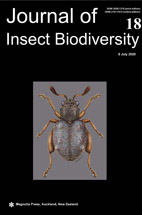Abstract
Mayflies are recognized as potential bioindicators of good water quality and they are not widely been studied in Indian subcontinent. So the current paper aims to describe the distribution and trophic categorization of mayflies in connection with stream order, mesohabitats and landscape elements. The study was carried out in 30 streams of Palni and Cardamom hills of Southern India from 2017–2018. A total of 10,075 individuals of mayflies were collected from 30 sites. The species richness among the six landscape elements (evergreen, semi evergreen, forestry plantation, areca nut, scrub and habitation) were examined and the outcomes show that streams moving through evergreen territories have more richness (25.6%) followed by semievergreen regions (23.2%) and no mayflies are acquired from pool. PCA results showed that among the mesohabitats; run, riffle and bank underpins the mayfly taxa. Functional Feeding Group (FFG) results shows 27 sites were overwhelmed by scrapers, 2 sites were dominated by collectors and in one site collectors and scrapers were equivalent. Ternary plot reveals scrapers were found to be predominant in all the stream orders. The present study also revealed that in Palni and Cardamom hills, larger numbers of species of Ephemeroptera were sampled from stream orders II and III contrast with stream orders I and IV.
Key words: Ephemeroptera, RCC, scrapers, arecanut, FFG
References
Allan J. David 1995. Stream ecology, structure and function of running waters. London: Chapman & Hall.
Balachandran C. & Ramachandra T. V. 2011. Distribution and Biology of the Mayflies (Ephemeroptera) of Western Ghats. Sahyadrie News 35:1–20.
Baptista D. F., Buss D.F., Dorvillé, L. F. M. & Nessiman J. L. 2001. Diversity and habitat preference of aquatic insects along the longitudinal gradient of the Macaé river basin, Rio de Janeiro, Brazil. Revista Brasileira de Biologia 61(2): 249–258. Italian (Italy)
https://doi.org/10.1590/S0034-71082001000200007
Brittain J. E. & Sartori M. 2009. Ephemeroptera:(Mayflies). In: Encyclopedia of insects (VH Resh and RT Cardé, editors). Academic Press, 2nd edition, Oxford, 328–334 pp.
https://doi.org/10.1016/B978-0-12-374144-8.00100-4
Burton T. M. & Sivaramakrisnan K. G. 1993. Composition of the insect community in the streams of the Silent Valley National Park in the Southern India. Journal of Tropical Ecology 34(1): 1–16.
Buss D. F., Baptista D. F., Nessimian J. L. & Egler M. 2004. Substrate specificity, environmental degradation and disturbance structuring macroinvertebrate assemblages in neotropical streams. Hydrobiologia 518: 179–188.
https://doi.org/10.1023/B:HYDR.0000025067.66126.1c
Coffman W. B. & Ferrington L. C. 1996. Chironomidae. In: An introduction to the Aquatic Insects of North America. (Merrit W. and Cummings K.W., editors). Kendall/Hunt Dubuque, 2nd edition, Iowa, 551–643 pp.
Cummins K. W. 1973. Trophic relation of aquatic insects. Annual Review of Entomology 18: 183–206.
https://doi.org/10.1146/annurev.en.18.010173.001151
Dudgeon D. 1999. Tropical Asian Streams: Zoobenthos, ecology and conservation. Hong kong University Press, Hong Kong, 830 pp.
Ferro M. L. & Sites R. W. 2007. The Ephemeroptera, Plecoptera and Tricoptera of Missouri State Parks, with Notes on Biomonitoring, Mesohabitat Associations, and Distribution. Journal of the Kansas Entomological Society 80(2): 105–129.
https://doi.org/10.2317/0022-8567(2007)80[105:TEPATO]2.0.CO;2
Ghate U., Joshi N. V. & Gadgil M. 1998. On the patterns of tree diversity in the Western Ghats of India. Current Science 75: 594–603.
Hammer O., Harper D. A. T. & Ryan P. D. 2001. PAST (Paleontological Statistics software package for education and data analysis). Palaeontologia Electronica 4(1): 9.
Merritt R. W. & Cummins K. W. 1996. An introduction to the aquatic insects of North America. 3rd edition. Dubuque IA: Kendall/Hunt Publishing Company.
Nagendra H. & Gadgil M. 1998. Linking regional and landscape scales for assessing biodiversity: A case study from Western Ghats. Current Science 75: 264–271.
Naiman R. J. & Decamps H. 1997. The ecology of interfaces: Riparian zones. Annual Review of Ecology, Evolution and Systematics 28: 621–658.
https://doi.org/10.1146/annurev.ecolsys.28.1.621
Nair N. B., Arunachalam M., Mathusoothanan Nair K. C. & Suryanarayanan H. 1989. A spatial study of the Neyyar River in the light of the River-Continuum-Concept. Tropical Ecology 30: 101–110.
Rosenberg D. M & V. H. Resh. 1993. Freshwater biomonitoring and benthic macroinvertebrates. New York: Chapman and Hall.
Sabo J. & Power M. 2002. River–watershed exchange: effects of riverine subsidies on riparian lizards and their terrestrial prey. Ecology 83:1860–1869.
https://doi.org/10.1890/0012-9658(2002)083[1860:RWEEOR]2.0.CO;2
Schlosser I. J. 1987. The role of predation in age- and size related habitat use by stream fishes. Ecology 68:651–659.
https://doi.org/10.2307/1938470
Selvakumar C., Sivaramakrishnan K. G., Janarthanan S., Arumugam M. & Arunachalam M. 2014. Impact of riparian land-use patterns on Ephemeroptera community structure in river basins of the southern Western Ghats, India. Knowledge and Management of Aquatic Ecosystems 412: 11.
https://doi.org/10.1051/kmae/2013093
Sivaramakrishnan K. G., Madhyastha N. A. & Subramanian K. A. 1998. Field guide to aquatic macroinvertebrates. Life Scape IISc, Bangalore, 8 pp.
Sivaramakrishnan K. G., Subramanian K. A., Ramamoorthy V. V., Sharma R. M. & Kailash Chandra. 2009. Checklist of Ephemeroptera of India. E-publication, Zoological Survey of India, Calcutta.
Sivaramakrishnan K. G., Venkataraman K., Sridhar S. & Marimuthu M. 1995. Spatial patterns of benthic macroinvertebrates distributions along river Kaveri and its tributaries (India). International Journal of Ecological and Environmental Sciences 21: 141–161.
Subramanian K. A., Sivaramakrishnan K. G. & Gadgil M. 2005. Impact of riparian land use on stream insects of KudremukhNational Park, Karnataka state, India. Journal of Insect Science 5: 10–49.
https://doi.org/10.1093/jis/5.1.49
Vadas R. L. & Orth D. J. 1998. Use of physical variables to discriminate visually determined mesohabitat types in North American streams. Rivers 6: 143–159.
Vannote R. L., Minshall G. W., Cummins K.W., Sedell J. R. & Cushing C. E. 1980. The river continuum concept. Canadian Journal of Fisheries and Aquatic Sciences 37: 130–137.
https://doi.org/10.1139/f80-017
Wallace J. B., Eggert S. L., Meyer J. L. & Webster J. R. 1997. Multiple trophic levels of a forest stream linked to terrestrial litter inputs. Science 277: 102–104.


